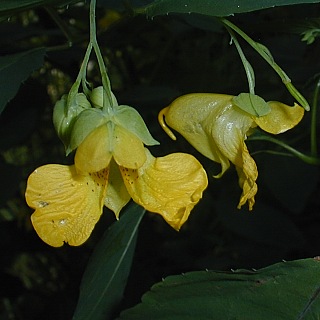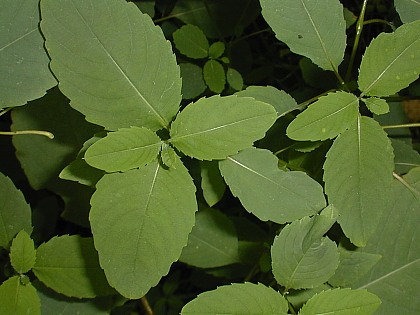Description:
This
wildflower is a summer annual about 3-6' tall, branching frequently.
The somewhat succulent stems are light green, glabrous, and glaucous.
The alternate leaves are up to 4" long and 2" across. They are ovate,
hairless, and serrated along the margins; their slender petioles are up
to 2" long. From the axils of the middle to upper leaves, short racemes of 1-3 flowers are
produced. Each flower is about 1–1¼" long, consisting of 5 petals, 3
sepals, and reproductive organs within the tubular corolla. This
corolla is yellow, or less often cream-colored, and consists of the
fusion (or near fusion) of the 5 petals and lower sepal. The lower
sepal is petaloid; it defines the conical posterior of the corolla,
which tapers to a tiny nectar spur that curls downward. The upper petal
defines the upper lip (or hood) of the corolla, while the two lower
petals form a pair of well-rounded lobes that are rather irregular and
wrinkled. Two small lateral petals define the sides of the corolla
opening, although they are difficult to see when the flowers are viewed
from above. There are usually reddish brown spots within the interior
of the corolla, although they are sometimes absent. The upper 2 sepals
are light green and ovate in shape; they are located at the top of the
corolla, rather than behind or underneath. Each flower dangles from a
slender pedicel about ¾" long. The blooming period occurs from
mid-summer to early fall and lasts about 2-3 months. Each fertilized
flower is replaced by an ellipsoid seedpod up to 2" long. This seedpod
is broadest toward the middle, tapering toward its tips; it has several
dark green lines along its length. As the seedpod ripens, it splits
open and ejects the seeds. The root system consists of a shallow
branching taproot.
axils of the middle to upper leaves, short racemes of 1-3 flowers are
produced. Each flower is about 1–1¼" long, consisting of 5 petals, 3
sepals, and reproductive organs within the tubular corolla. This
corolla is yellow, or less often cream-colored, and consists of the
fusion (or near fusion) of the 5 petals and lower sepal. The lower
sepal is petaloid; it defines the conical posterior of the corolla,
which tapers to a tiny nectar spur that curls downward. The upper petal
defines the upper lip (or hood) of the corolla, while the two lower
petals form a pair of well-rounded lobes that are rather irregular and
wrinkled. Two small lateral petals define the sides of the corolla
opening, although they are difficult to see when the flowers are viewed
from above. There are usually reddish brown spots within the interior
of the corolla, although they are sometimes absent. The upper 2 sepals
are light green and ovate in shape; they are located at the top of the
corolla, rather than behind or underneath. Each flower dangles from a
slender pedicel about ¾" long. The blooming period occurs from
mid-summer to early fall and lasts about 2-3 months. Each fertilized
flower is replaced by an ellipsoid seedpod up to 2" long. This seedpod
is broadest toward the middle, tapering toward its tips; it has several
dark green lines along its length. As the seedpod ripens, it splits
open and ejects the seeds. The root system consists of a shallow
branching taproot.
Cultivation:
The preference is partial sun, wet to moist conditions, and soil that
is loamy or mucky. Yellow Jewelweed also tolerates full sun, light
shade, and mesic conditions (if it receives some protection from the
afternoon sun). This species is a little more tolerant of dry
conditions than Impatiens capensis (Orange
Jewelweed). It grows rapidly from seed during the summer and can
achieve an impressive size.
Range & Habitat:
The native Yellow Jewelweed occurs occasionally in central and northern
Illinois;
it is less common or absent in the southern portion of the state (see Distribution
Map). Habitats include muddy borders along ponds and streams
(especially in wooded areas), swamps, openings in moist deciduous
woodlands, and soggy thickets. Sometimes this species is cultivated in
gardens.

Faunal
Associations:
The nectar of the flowers attracts the Ruby-Throated Hummingbird and
bumblebees; the latter are especially common visitors. The caterpillars
of various moths feed on the foliage, including Euchlaena
obtusaria (Obtuse Euchlaena), Spilosoma latipennis
(Pink-Legged Tiger Moth), Trichodezia albovittata
(White-Striped Black), and Xanthorhoe lacustrata
(Toothed Brown Carpet). The large seeds are eaten by various gamebirds,
including the Ruffed Grouse, Ring-Necked Pheasant, Greater Prairie
Chicken, and Bobwhite Quail. The White-Footed Mouse also eats the
seeds. White-Tail Deer browse on the foliage.
Photographic Location:
The photographed plants were growing along the back alley of a
residential area in Urbana, Illinois.
Comments:
Yellow Jewelweed is closely related to the more common Impatiens
capensis (Orange Jewelweed). It is very similar in appearance
to the latter species, except that its flowers are yellow, rather than
orange. The tubular corolla of Yellow Jewelweed is broader toward its
posterior, and its 2 lower petals are divided at the base, rather than
fused together. Both of these Jewelweeds have attractive foliage and
large interesting flowers that bloom over an extended period of time.